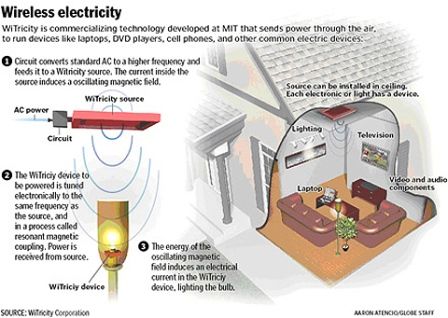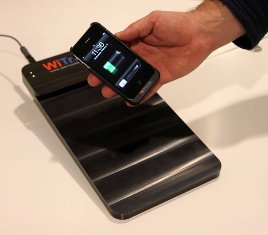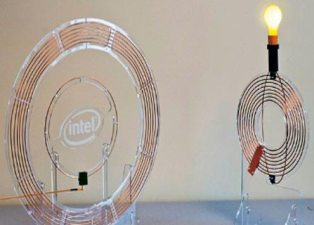Categories: Interesting Facts, Interesting electrical news
Number of views: 45750
Comments on the article: 12
Wireless power transmission: a difficult history of becoming
 Of the long list of fantastic technical ideas implemented today, only the dream of wireless transmission of electrical energy continues to remain unassailable. Detailed descriptions of energy rays in science fiction novels tease engineers with their obvious need, and at the same time the practical impossibility of implementation. But the situation is gradually changing for the better.
Of the long list of fantastic technical ideas implemented today, only the dream of wireless transmission of electrical energy continues to remain unassailable. Detailed descriptions of energy rays in science fiction novels tease engineers with their obvious need, and at the same time the practical impossibility of implementation. But the situation is gradually changing for the better.
From the very beginning of the discovery of electricity, there was a problem of its transmission to the final consumer. The development of industrial production has led to a sharp increase in demand for electricity. Wires and poles of electric transmission lines have become an integral element of landscapes. But only specialists know how much money and effort is spent on maintaining these lines in working condition, and how much energy is lost in them.
Fossil resources are gradually running out, and energy supply problems are pushing hard at the door of energy. Modern human society has entered the era of space exploration, so our views turn to the obvious source of inexhaustible energy - the Sun. For billions of years, this thermonuclear reactor emits fantastic amounts of energy, a small part of which would be enough for humanity for many years. But one “small” problem: how to transfer the received energy to the consumer on Earth?
From this moment, a serious discussion begins about the possibilities of making humanity happy with unlimited resources. So far, there are two ways to solve the problem in the list of modern space technology tools. One is related to laser beam energy transfer to ground receiving terminals. Second - with microwave energy transfer.
Laser energy transfer encounters several fundamental difficulties. The first is related to the efficiency of the primary conversion of solar radiation into coherent laser radiation. And the second rests on the efficiency of energy transfer from space to Earth. On the first problem, there has been progress: scientists from Japan reported the conversion of solar energy into laser radiation with an efficiency of 42%. But the transfer of energy to the surface involves a number of tasks that are difficult to solve.
Attenuation of a laser beam whose diameter at the surface of the Earth can be hundreds of meters. Its intensity depends on weather conditions, the accuracy of pointing at the receiving terminal, and even the mass of parameters. Flying planes or flocks of birds caught in a power ray will distort or weaken its power. If such an incident goes unnoticed for an airplane, then the birds will suffer significantly: the radiation intensity near the surface of the Earth will be tens of times more powerful than the midday Sun.
The second way of energy transfer is microwave waves with frequencies from 2.4 to 5.8 GHz. Here there is an atmospheric “window” in which the attenuation of energy is minimal. But the receiving part of the energy is very complex and requires the development of modern antenna components. According to scientists, for transmitting a power of 5 MW from a height of 36,000 km (geostationary orbit), a transmitting antenna 1 km in size and a receiving antenna 10 km across will be required. Such facilities in the near future for humanity can not afford.
In this situation, progress began on the other side. The development of modern communications and mobile computing devices has required frequent recharging of their batteries. In principle, this does not present a particular problem, especially when you have one or two such devices. But if there are dozens of them in the family or office, then the continuous search for charging units compatible with products is distracting and annoying.
According to rumors, it was this circumstance that prompted Marina Solyachich, an employee of the University of Massachusetts, to The idea of a way to transfer energy without wires. After the signal of a discharged mobile phone woke him several times in the middle of the night, he decided to seriously tackle the problem wirelessly charge your mobile devices.
As a result, it appeared completely new technology for transferring energy from the network to mobile devices. The method consists in resonant coupling using the magnetic field of the receiver and transmitter. Behind an incomprehensible name and no less obscure mechanism (the method is patented and kept secret), there is hidden a method of energy transfer without conductors with an efficiency of more than 40%. The technology is called WiTricity.

The principle of operation of technology for energy transfer without wires "WiTricity"
Wireless Charger for WiTricity Mobile Phone
According to the authors of the invention, this is not a “pure” resonance of the connected circuits and is not Tesla Transformer, with inductive coupling. The radius of energy transfer today is a little more than two meters, in the future - up to 5-7 meters.
Similar technologies are feverishly developed by other firms: Intel has demonstrated its technology WREL with energy transfer efficiency up to 75%. In 2009, Sony demonstrated the operation of a television without a network connection.
Technology demonstration WiTricity:
Intel WREL Wireless Technology Demonstration:
Only one circumstance is alarming: regardless of the transmission method and technical tricks, the energy density and field strength in the rooms should be high enough to power devices with a power of several tens of watts.
According to the developers themselves, information on the biological effects on humans of such systems is not yet available. Given the recent appearance, and a different approach to the implementation of energy transmission devices, such studies are yet to come, and the results will not appear soon. And we can judge their negative impact only indirectly. Something again will disappear from our homes, such as cockroaches.
Without trying to delve into the intricacies of energy transfer technologies, we can say that at the level of distances up to 10 meters in the near future, wireless energy transfer devices will become a reality. You can watch TV, use a computer and charge mobile devices without worrying about the presence of cords and sockets.
But we started with transmission problems not of tens and hundreds of watts, but of more serious capacities. Unfortunately today The best achievement in this direction is the pilot transmission of 30 kilowatts of power over a distance of 2 kilometers (1 mile). This event happened back in 1975 and since then no serious progress has been made. Therefore, in the coming decades, one should not expect a breakthrough in the field of wireless energy transmission. Science fiction can sleep so far.
See also at e.imadeself.com
:


